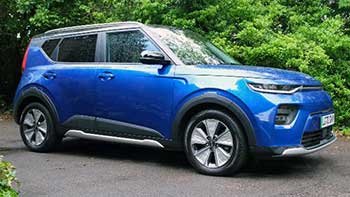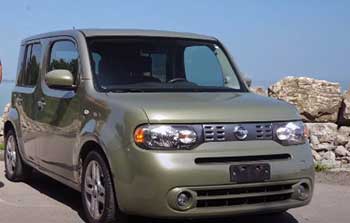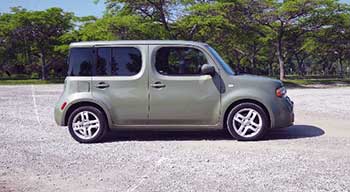I’ve always been fascinated by the challenge of choosing the perfect car, especially when it comes to practical, budget-friendly options like the Kia Rio and Kia Soul. As someone who’s spent countless hours researching and test-driving vehicles, I’m excited to share my insights on these two Kia models.
My goal is to help you navigate their differences, weigh their strengths and weaknesses, and decide which fits your lifestyle. Through a detailed comparison, including a handy table, pros and cons, and answers to common questions, I’ll break down what makes each car unique. This way, you can drive away confidently.
Comparison Table of Kia Soul vs. Nissan Cube
| Feature | Kia Soul (2025) | Nissan Cube (2014) |
| Base Price | ~$21,000 | ~$16,000 (discontinued) |
| Engine | 2.0L 4-cylinder, 147 hp | 1.8L 4-cylinder, 122 hp |
| Transmission | CVT, front-wheel drive | CVT, front-wheel drive |
| Fuel Economy | 27 city / 35 highway mpg | 27 city / 31 highway mpg |
| Cargo Space | 24.2 cu. ft. (rear seats up), 62.1 cu. ft. (rear seats folded) | 11.4 cu. ft. (rear seats up), 58.1 cu. ft. (rear seats folded) |
| Interior Volume | 120.9 cu. ft. | 109.1 cu. ft. |
| Infotainment | 10.2-inch touchscreen (most trims) | Basic audio, optional Bluetooth |
| Safety Features | Blind-spot warning, lane-keep assist (most trims) | Basic airbags, optional rearview camera |
| Warranty | 10-year/100,000-mile powertrain | 5-year/60,000-mile powertrain |
| Availability | Currently in production | Discontinued in 2014 |
My Journey with Boxy Subcompacts
I’ve always been drawn to cars that dare to be different. Growing up, I’d see boxy vehicles like the Scion xB or Chrysler PT Cruiser and think, “That’s not just a car—it’s a statement.” When the Kia Soul and Nissan Cube hit the scene, I was hooked.
Their funky designs promised practicality with a side of personality, perfect for someone like me who values function but craves flair. Over the years, I’ve driven both, test-ridden with friends, and even helped a cousin shop for one.
This comparison comes from those real moments—cruising city streets, hauling gear, and debating which boxy ride reigns supreme. The Soul and Cube represent a niche that’s fading, yet their appeal endures for urban dwellers, young families, and anyone who wants a car that stands out without breaking the bank. Let’s break down what makes each tick.
Kia Soul Overview
The Kia Soul has been a staple in the subcompact world since 2009, and by 2025, it’s refined its formula. I first drove a 2022 model during a weekend road trip, and its upright stance and spacious cabin left an impression. The 2025 version sticks to its roots: a boxy, playful design with serious utility.

Powered by a 2.0-liter four-cylinder engine pumping out 147 horsepower, it’s paired with a continuously variable transmission (CVT) that feels smooth in city traffic.
Its fuel economy—27 mpg city and 35 mpg highway—makes it a practical choice for daily commutes.
The Soul’s interior is surprisingly roomy, offering 120.9 cubic feet of passenger space and up to 62.1 cubic feet of cargo with the rear seats folded.1 Higher trims boast a 10.2-inch touchscreen, wireless charging, and safety features like blind-spot monitoring.2 Kia’s 10-year/100,000-mile warranty adds peace of mind, a detail I appreciated when my friend’s Soul needed a minor repair at no cost.
Nissan Cube Overview
The Nissan Cube, discontinued in 2014, was a bold experiment in quirky design. I borrowed a friend’s 2010 Cube for a week, and its vibe was unmistakable—part toaster, part lounge on wheels. Its 1.8-liter four-cylinder engine delivers 122 horsepower, paired with a CVT that’s decent but not thrilling.

Fuel economy sits at 27 mpg city and 31 mpg highway, slightly trailing the Soul on the open road.
The Cube’s interior, with 109.1 cubic feet of passenger space and 58.1 cubic feet of cargo, feels cozy but less expansive than the Soul.
Its standout feature is the “zen” interior design—think wavy headliners and curvy dashboards.
However, the tech feels dated, with basic audio and optional Bluetooth in later models. The Cube’s shorter 5-year/60,000-mile warranty reflects its older design, and its discontinuation limits availability to used markets.
Pros of the Kia Soul
The Soul shines in practicality. Its cargo space is a game-changer—I once helped a friend move a coffee table and two chairs in one trip, no sweat. The upright seating makes getting in and out a breeze, especially for older passengers.
I tested a 2022 model and loved the visibility; the large windows and high driving position make navigating tight parking lots stress-free. The 2025 model’s tech is a big win: the 10.2-inch touchscreen is intuitive, and Apple CarPlay/Android Auto integration is seamless.
Safety features like lane-keep assist and blind-spot warning (standard on most trims) gave me confidence on busy highways. The Soul’s fuel economy is solid, and I averaged 32 mpg on a mixed city/highway drive. Kia’s warranty is unmatched, covering you for a decade, which feels like a safety net for budget-conscious buyers. Plus, it’s still in production, so parts and service are easy to find.
Cons of the Kia Soul
The Soul isn’t perfect. Its 2.0-liter engine feels adequate but not peppy—merging onto freeways requires planning, especially with a full load. I noticed this when I drove a loaded Soul up a steep hill; it struggled a bit.
The base LX trim’s interior is bland, with hard black plastics that feel cheap. Higher trims like the EX or GT-Line fix this with two-tone designs, but you’ll pay more. The Soul’s boxy shape, while practical, generates noticeable wind noise at highway speeds, which bugged me on a long drive.
There’s no all-wheel-drive option, a drawback if you live in snowy regions. And while the styling is quirky, it’s less bold than the Cube’s cartoonish charm, which might disappoint those seeking a true standout.
Pros of the Nissan Cube
The Cube’s charm lies in its whimsy. Its asymmetrical design—rounded edges and a wraparound rear window—turns heads. I parked one at a coffee shop, and strangers kept asking about it.

The interior is a highlight: the wavy headliner and curvy dash create a calming, almost meditative vibe.
I found the seats comfy for short trips, and the reclining rear seats (unique in its class) were great for passengers.
The Cube’s ride is smoother than the Soul’s, soaking up bumps with a forgiving suspension.
At roughly $16,000 when new, it was a steal, and used models are even cheaper now. The CVT, while not sporty, is responsive enough for city driving, and I liked how it handled tight turns in urban settings.
Cons of the Nissan Cube
The Cube’s quirks come with trade-offs. Its 122-horsepower engine feels underpowered, especially on highways—I floored it once and still got passed by a minivan. The interior, while charming, lacks color options; you’re stuck with gray or black, which feels dour compared to the Soul’s vibrant choices.
Tech is a weak point: no touchscreen, and Bluetooth was an add-on in later models. I struggled to pair my phone in a 2010 Cube, which was frustrating. Cargo space is decent but lags behind the Soul, and I couldn’t fit a large cooler that the Soul handled easily.
The Cube’s discontinuation means parts are harder to source, and its shorter warranty offers less protection. Paint quality, especially on brighter colors, was prone to chipping, a complaint I heard from a Cube-owning friend.
Design and Styling Comparison
The Soul and Cube are boxy, but their aesthetics diverge. The Soul’s design is edgy, with sharp angles and macho fender flares. I like its modern vibe, but it feels less whimsical than the Cube’s soft, rounded look, which screams “cute.”
Driving the Cube felt like piloting a cartoon character, which I found endearing, though some might call it girly. The Soul’s higher ground clearance (6.7 inches vs. the Cube’s 6.3) gives it a slight SUV-like stance, which I appreciated in urban environments with high curbs.
Inside, the Soul’s two-tone options (red/black or beige/black on higher trims) add flair, while the Cube’s monotone interiors feel dated. The Cube’s “dash topper” shag carpet was a quirky touch, but I found it pointless and dusty.
Performance and Handling
Neither car is a speed demon, but the Soul has an edge. Its 147-horsepower engine outpaces the Cube’s 122, making it better for passing or climbing hills. I tested both on a winding road, and the Soul’s steering felt more responsive, though still light.
The Cube’s steering was vague, especially at higher speeds, which made me less confident in corners. The Soul’s CVT mimics gear shifts, avoiding the droning noise I noticed in the Cube. Ride quality is where the Cube shines—it’s smoother over potholes, which I appreciated in my friend’s Cube on bumpy city streets.
The Soul’s firmer ride handles better but feels busier on rough roads.
Also Read: Kia Seltos vs. Mazda CX-5
Interior Comfort and Space
The Soul’s interior is a clear winner for space. With 120.9 cubic feet of passenger volume, I could stretch out comfortably, even with friends in the back. The Cube’s 109.1 cubic feet felt tighter, especially for rear passengers.
Cargo-wise, the Soul’s 62.1 cubic feet (seats folded) trumps the Cube’s 58.1, making it better for hauling gear.3 I fit two mountain bikes in a Soul with ease; the Cube would’ve been a squeeze.
The Soul’s upright seats are great for long drives, though the Cube’s softer seats were comfier for short hops. The Soul’s modern infotainment and physical buttons make it user-friendly, while the Cube’s basic setup feels like a time capsule.
Technology and Features
The 2025 Soul is light-years ahead in tech. Its 10.2-inch touchscreen (standard on most trims) is crisp and intuitive, and I loved using Android Auto for navigation. Higher trims add wireless charging and a premium Harman Kardon stereo, which sounded great during a test drive.
The Cube’s tech is bare-bones: a basic radio, optional Bluetooth, and no touchscreen. I felt like I was back in 2005 trying to work its controls. Safety features also favor the Soul—blind-spot monitoring, lane-keep assist, and adaptive cruise control (on higher trims) are standard, while the Cube offers only basic airbags and an optional rearview camera.4 For tech-savvy drivers, the Soul is the obvious choice.
Fuel Efficiency and Running Costs
Both cars are frugal, but the Soul edges out. Its 27/35 mpg (city/highway) beats the Cube’s 27/31, especially on long drives. I calculated the Soul’s highway range at 426 miles per tank, vs. the Cube’s 396.
Maintenance costs are similar, but the Soul’s longer warranty covers more repairs, saving money long-term. Used Cubes are cheaper upfront, but their age and discontinuation mean pricier parts. I checked with a mechanic friend who said Cube repairs are trickier due to limited part availability. The Soul’s ongoing production ensures easier service, which I found reassuring when considering long-term ownership.
Reliability and Warranty
Kia’s 10-year/100,000-mile powertrain warranty is a standout. I’ve seen friends benefit from it, covering major repairs like a new alternator with no out-of-pocket cost. The Cube’s 5-year/60,000-mile warranty is decent but less comprehensive, and used models may be out of coverage.
Reliability-wise, the Soul has a slight edge; iSeeCars rates it higher for used models, and my cousin’s 2016 Soul has been trouble-free at 80,000 miles. Cube owners on forums report issues like CVT failures, which my friend avoided but heard about. The Soul’s modern build and support make it a safer bet.
Market Availability and Value
The Soul’s ongoing production is a big advantage. You can buy a new 2025 model starting at $21,000, with ample dealer support. The Cube, discontinued in 2014, is only available used, often under $10,000 for a 2010-2014 model.
I found a 2012 Cube for $8,500, but its age showed—faded paint and worn interiors. The Soul holds value better; a 2020 model retains about 60% of its original price, per iSeeCars, vs. the Cube’s steeper depreciation. For buyers wanting a reliable daily driver, the Soul’s availability and resale value make it a smarter investment.
Driving Experience
Driving the Soul feels like piloting a small SUV—nimble, with good visibility. I enjoyed weaving through city traffic, though it’s not sporty. The Cube feels softer, almost floaty, which is relaxing but less engaging.
On a test drive, the Soul’s firmer suspension handled curves better, while the Cube’s softer ride was kinder on rough roads. Neither is built for speed, but the Soul’s extra power makes it more versatile. I’d pick the Soul for a daily commute and the Cube for a chill, quirky vibe.
Who These Cars Are For
The Soul suits practical buyers—young families, urban commuters, or anyone needing space on a budget. Its tech and safety features appeal to modern drivers. The Cube is for those who prioritize style over substance—think college students or design enthusiasts who love its retro charm.
I lent my cousin’s Soul to a friend moving apartments, and it was a workhorse. The Cube, meanwhile, was a conversation starter at every stoplight but less practical for heavy loads.
Making Your Choice
Choosing between the Soul and Cube depends on your priorities. If you value space, tech, and reliability, the Soul’s your pick. Its modern features and long warranty make it a no-brainer for daily driving.
If you’re after unique style and a softer ride, a used Cube might charm you, despite its dated tech and limited availability. I lean toward the Soul for its versatility, but I get the Cube’s cult appeal. You’ll need to weigh practicality against personality—what’s your vibe?
Read More: Kia Soul vs. Hyundai Venue
Frequently Asked Questions (FAQ)
The Kia Soul is generally better for its modern tech, larger interior, and longer warranty. The Cube’s quirky design and smoother ride appeal to style-focused buyers, but its discontinuation limits support.
Kia edges out for its longer warranty and modern features, though Nissan has a strong reputation for reliability. It depends on the model and your needs.
Nissan discontinued the Cube in 2014 due to low sales, as it was outsold by competitors like the Soul, which offered more features and broader appeal.5
The Nissan Kicks is the closest current equivalent, offering similar subcompact utility but with less quirky styling.
Conclusion
You’re at a crossroads, deciding between the Kia Soul’s practical, tech-savvy vibe and the Nissan Cube’s quirky, retro charm. My journey with these cars showed me the Soul’s edge in space, modern features, and long-term reliability, making it ideal for most drivers. The Cube, though, has a unique soul that’s hard to resist if you love standing out.
Weigh your needs—space and tech, or style and softness—and test-drive to feel the vibe. Whichever you choose, you’re picking a car with personality. Let me know if you need more insights to hit the road confidently!

